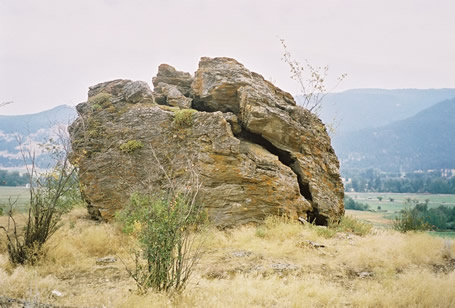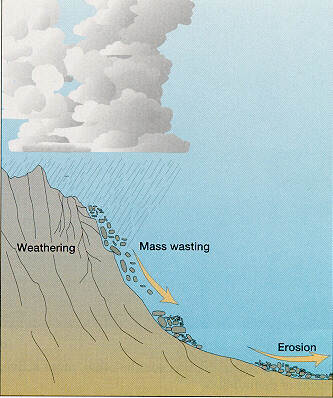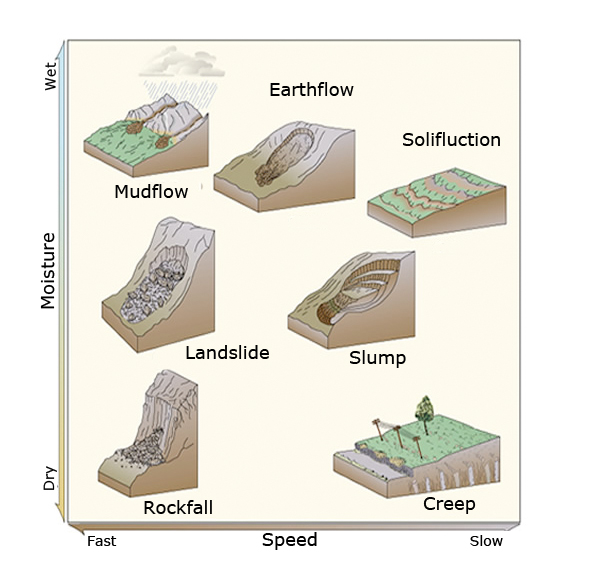EXPLORATION: Weathering and Erosion
| Site: | MoodleHUB.ca 🍁 |
| Course: | World Geography 30 |
| Book: | EXPLORATION: Weathering and Erosion |
| Printed by: | Guest user |
| Date: | Wednesday, 24 December 2025, 11:21 AM |
1. Introduction
In order to understand weathering and erosion, you first need to understand the concept of gradation.
Gradation is the process of levelling the land by means of moving agents like rivers, winds, sea and waves. The highlands are made low by erosion or wearing away and the lowlands are raised by adding the eroded material by the process of deposition. In spite of the fact that gradation has continued for eons, the land has not become level. This is because there is constant earth movement which raises mountains and plateaus and therefore gradation is a continuous process.
In a sense, you can consider the forces of gradation and tectonics as one of an ongoing battle. Tectonic forces pushes the land upwards and gradation wears it down in a constant process of levelling. The levelling takes place in two ways - tearing down, or erosion, and filling in, called deposition.
The cycle of gradation is that of weathering, transportation and deposition.
In this photo below, you can see how glacial silt has been deposited at the mouth of a river going into a lake.

2. Mechanical and Chemical Weathering
Mechanical Weathering
Mechanical Weathering is the breaking up of rocks into smaller fragments without any change in the chemical composition of its minerals.
Start this lesson by watching the four minute video on weathering and erosion below. Don't balk at the word "kids" in the title. It is actually a good introduction to the topic of weathering for anyone.
Types of mechanical weathering
exfoliation or spheroidal weathering
- daily variations in temperature cause rocks to expand and contract
- various minerals in a rock expand and contract at different rates; as a result there is a gradual splitting apart of the rock
- in humid climates, running water tends to round off the surface features causing the "skin" of the rock to peel off
- this is also an important form of weathering in desert areas where the daily temperature range can be high
freeze-thaw or frost action (thermal expansion)
- when the water in the cracks and pore spaces of rocks freezes, the force created by its expansion is tremendous
- rocks are literally split apart resulting in shattering
-
An example of the powerful force of freeze thaw action on a large boulder below

A glacial erratic near Vernon, BC (Courtesy: P. Mleziva)
plants and roots
- tree roots, for example, growing down into cracks can exert powerful forces
- even mosses and lichens can help to split rocks apart
Chemical Weathering
Chemical Weathering is the decay of rock through actual chemical change in the composition of its minerals. It is most common in warm and humid climates where both water and heat speed up chemical reactions.
Types of Chemical Weathering
carbonation or solution
- occurs with limestone (easiest to erode)
- ground water absorbs carbon dioxide to form a slightly acidic solution
hydrolysis
- occurs especially with granite
- causes rock to whiten (erodes slowly)
- creates clay
oxidation
- creates rusty red rock
- occurs especially with rock containing iron nitrate
- erodes and forms soil
hydration
- occurs especially with rocks containing salt minerals
- water is absorbed into the internal structure of the rock causing swelling and making it vulnerable to breakdown due to pressure and potential chemical structure changes
- a physio-chemical process eg gypsum results from water being added to anhydrite (CaSO4)

Above, workers clear debris from a road near Samaipata, Bolivia.
The rusty red colour tells you that this rock contains iron which has undergone oxidation.
Also, water has been able to penetrate this sandstone which has caused the erosion resulting in the sandstone falling on to the road.
photo by Nick Smith
3. Mass Movement
Mass movement, also called Mass Wasting, includes bulk movements of soil and rock debris down slopes in response to the pull of gravity, or the rapid or gradual sinking of the Earth’s ground surface in a predominantly vertical direction. Formerly, the term mass wasting referred to a variety of processes by which large masses of crustal materials are moved by gravity from one place to another.
More recently, the term mass movement has been substituted to include mass wasting processes and the sinking of confined areas of the Earth’s ground surface. Mass movements on slopes and sinking mass movements are often aided by water and the significance of both types is the part each plays in the alteration of landforms.
The variety of downslope mass movements reflects the diversity of factors that are responsible for their origin. Such factors include: weathering or erosional debris cover on slopes, which is usually liable to mass movement; the character and structure of rocks, such as resistant permeable beds prone to sliding because of underlying impermeable rocks; the removal of the vegetation cover, which increases the slope’s susceptibility to mass movement by reducing its stability; artificial or natural increases in the slope’s steepness, which will usually induce mass movement; earthquaketremors, which affect the slope equilibrium and increase the likelihood of mass movement; and flowing ground water, which exerts pressure on soil particles and impairs slope stability. These factors affecting slope conditions will often combine with climatic factors such as precipitation and frost activity to produce downslope mass movement.
The types of mass movements caused by the above factors include: the abrupt movement and free fall of loosened blocks of solid rock, known as rockfalls; several types of almost imperceptible downslope movement of soil particles and rock debris, collectively called creep; the subsurface creep of rock material, known as bulging: and the multiplicity of downslope movements of bedrock and other debris caused by the separation of a slope section along a plane of least resistance or slip surface, collectively called landslides.
Text above from Britannica - Mass Movement
 |
|
Types of mass wasting

Courtesy: University of Texas
Talus Slope
A collection of angular rock fragments at the base of a cliff is called a talus slope which is made of scree. Watch the short video below which analyzes a talus slope made of scree.
4. Wind Erosion
Most erosion in a desert is done by wind. This action of wind eroding, transporting and depositing sediments if called aeolian erosion.
Wind accomplishes this erosion by using fine sand particles like sandpaper, which abrades the rock, wearing it away. How much erosion occurs depends on wind speed, the size of carried particles and the hardness of the material being eroded. Difference in rock hardness can often lead to strange formations in desert environments where softer rock is eroded and harder rock remains.
Look at the photo below, which shows Cappadocia region of Turkey, where these hoodoos or fairy chimneys form. What might you assume about the hardness of the different layers of rock? How did these comes to be eroded like this, assuming that this is a desert?

photo from Alwayswanderlust.com
5. Coastal Erosion
The ocean is a huge force of erosion. Coastal erosion—the wearing
away of rocks, earth, or sand on the beach—can change the shape of
entire coastlines. During the process of coastal erosion, waves pound
rocks into pebbles and pebbles into sand. Waves and currents sometimes
transport sand away from beaches, moving the coastline farther inland.
Coastal
erosion can have a huge impact on human settlement as well as coastal
ecosystems. The Cape Hatteras Lighthouse, for example, was nearly
destroyed by coastal erosion. The Cape Hatteras Lighthouse was built on
the Outer Banks, a series of barrier islands off the coast of the U.S.
state of North Carolina, in 1870. At the time, the lighthouse was nearly
457 meters from the ocean. Over time, the ocean eroded most of the
beach near the lighthouse. By 1970, the pounding surf was just 37 meters
away and endangered the structure. Many people thought the lighthouse
would collapse during a strong storm. Instead, it was moved 880 meters
inland. Below, you can see a photo of the Cape Hatteras Lighthouse being
moved. Photo from National Park Service.

The
battering force of ocean waves also erodes seaside cliffs. The action
of erosion can create an array of coastal landscape features. For
example, erosion can bore holes that form caves. When water breaks
through the back of the cave, it can create an arch. The continual
pounding of waves can cause the top of the arch to fall, leaving nothing
but rock columns called sea stacks. The sea stacks at San Josef Bay
(below), on Vancouver Island are among the most dramatic and well-known
of these features of coastal erosion.

photo above Nick Smith
text on this page from National Geographic - Erosion
6. Gradational processes and humans
Humans both benefit and are harmed by the gradational processes of weathering and erosion.
Benefits
- agriculture
- provides water for agriculture,
- flooding gives nutrients to agricultural land, - transportation
- rivers have provided transportation for man for thousands of years - recreation
- lakes, rivers, waterfalls provide recreational opportunities for humans - drinking water
- humans use groundwater or surface water for drinking water supplies
Harms
- landslides/avalanches
- if humans build homes in area prone to landslides and avalanches, damage, injury or death will eventually occur. - flooding
- humans like to build on flood plains, due to flat terrain and good soil for agriculture.
- unfortunately, this means homes can be damaged by flooding or lives may be lost, unless humans build domes to control runoff. - loss of land
- erosional forces may take away land people own near rivers or coastlines - subsidence
- erosional forces may cause land to subside (sink) damaging homes and infrastructure
Many human activities such as road building, storm sewers, building dykes and deforestation can change gradational processes and cause disasters like floods and slides.